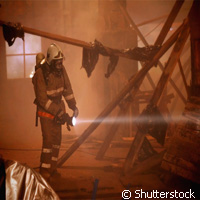Communication in crisis situations aided by innovative EU-funded research
Communication between rescue workers after a terrorist attack or a natural disaster could soon be made more efficient thanks to new EU-funded research. As part of the PEACE ('IP[Internet Protocol]-based emergency applications and services for next generation networks') project, which is funded under the 'Information and communication technology' (ICT) Theme of the EU's Seventh Framework Programme (FP7), a team of researchers from Kingston University in the United Kingdom developed an innovative new solution to ensure that communication cuts in disaster situations no longer hamper rescue efforts. Inspired by some of the problems faced by the emergency services during the aftermath of the London bombings, the team constructed an Internet-based 'app' that can keep rescuers and their central control room in touch independently, opposed to relying on central wireless access points or the TETRA police radio system. The app, which can be used on an iPad or on any other personal digital assistant (PDA) device, also has the capacity to allow emergency service workers in the United Kingdom to talk to their counterparts in other Member States using a secure system. Dr Christos Politis, who led the design team, comments: 'This research looked at how we communicate in a major disaster or emergency. When there's a major terrorist event, earthquake or forest fire, traditional phone lines and radios often can't cope and tend to jam because of the volume of calls and other multimedia traffic, like video. Using our new application, emergency service staff will be able to communicate on their own autonomous network using any available smart device without having to rely on a central communication system.' To develop the app, the team built on existing work into mobile networks, known as MANETs. These are networks of mobile devices that work independently and are connected by individual wireless links. Rather than connecting through an external Internet network, the new technique allows rescue workers to set up an independent communication system designed for their specific purposes at the scene, whatever the situation or location - be it an underground tube station or next to a collapsed office block. The design allows one of the mobile devices carried by a rescue worker to act as the super-node - a bit like a mini satellite - letting other mobile devices communicate with each other. As soon as a device passes a virtual intelligence security check, it can start to find others in the location. Each worker can then talk or send video or data to individual workers or entire groups. The team from the United Kingdom also worked closely with the other seven partners involved in the PEACE project, spread across Greece, Germany, France, Portugal, Spain and Sweden. This collaborative approach allowed the different teams, which were all working on how to apply next generation networks and all-IP infrastructure networks to disaster scenarios, to share their findings and pull together knowledge. For example, the Kingston researchers ensured their app was compatible with new sensors being developed by some of the other collaborators on the PEACE project. Dr Politis explains how these sensors, which could soon be a feature of many public buildings, can help facilitate a rescue effort. 'In the future the technology will also be able to act as sensors and pick up humidity levels, workers' heart rates, temperatures, movement and pass these on to a central operator. These statistics can then be checked by central control workers who can advise crews if they need to get out if it is getting too hot for example.' The overall objective of the PEACE project is to provide a general emergency management framework addressing extreme emergency situations such as terrorist attacks and natural catastrophes, as well as day-to-day emergency cases based on the IP Multimedia Subsystem (IMS). Dr Politis hopes his team's new app is the beginning of a new dawn in rescue operations: 'If the application takes off then in the future it could transform the way rescuers search for survivors in an earthquake. We could see an emergency button you could press on your smart phone if you were trapped under rubble and this could send your co-ordinates to rescuers' devices without you even having to call 999.'For more information, please visit:Kingston University:http://www.kingston.ac.uk/
Countries
Germany, Greece, Spain, France, Portugal, Sweden, United Kingdom



